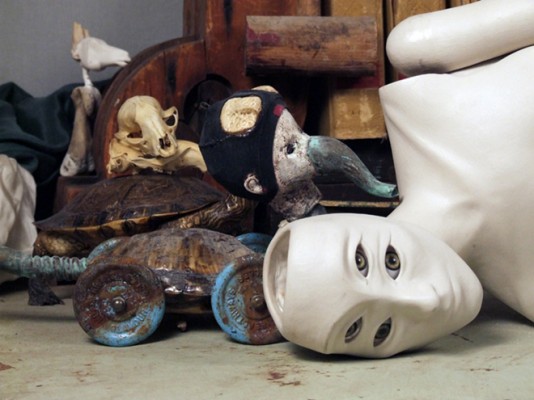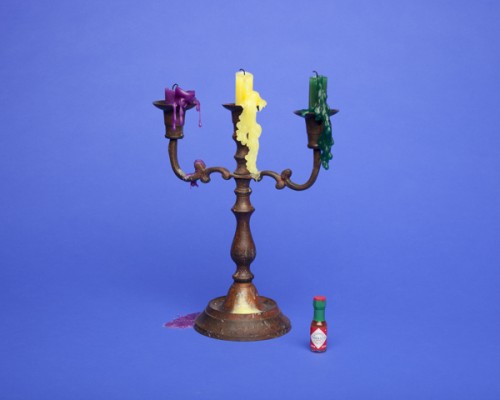Finding and Losing New Orleans

Michele Basta, Arachne, 2009. Stop-motion film (still). Courtesy the artist.
Editor's Note
By this point, many Pelican Bomb readers have seen “NOLA NOW, Part I: Swagger for a Lost Magnificence,” the thirty-five-artist snapshot of art practices in New Orleans on view at the Contemporary Arts Center. Far less may be aware of the short essays that Amy Mackie, Director of Visual Arts and curator of the show, has been writing. Before taking a break for the holidays, the Pelican wanted to share one of Mackie’s earliest essays from the series. In the weeks to come she’ll be adding more, so check back in at nolanow.cacno.org. But this one, in which Mackie muses on memory and silence, exemplifies the contemplative, hopeful spirit that characterizes the season with the passing of one year to the next.
See you in 2012!
My apartment, housed in a building that was once Mintz & Mintz Furniture, overlooks the Civic Theater. Built in 1906 by local architect Sam Stone, it is the oldest surviving theater in New Orleans. First a playhouse known as the Shubert (intended by the Shubert Brothers of New York to be the New Orleans branch of their nationwide chain of theaters), later called the Lafayette, the Star, and the Poche, over the years it also functioned as a movie theater as well as a venue for live acts. For a short time in the 1970s it was a Studio 54-esque discotheque called simply, Civic Disco. From Vaudeville to John Coltrane, the Civic served an important role in the cultural landscape of New Orleans. Ask any taxi driver in the city and he’ll tell you a story about this theater. Since I arrived in January, I’ve spent countless hours staring at the roof of this empty building and finally, a few weeks ago, I got a peek inside. I was not disappointed. Remnants of its magnificence remain and though it now bears the mark of time, it stands as a repository of memories and moments that permeates the structure. It is, but one of numerous such buildings throughout a city that seems to have found a way to outwit time. The legacy of this building has remained on my mind over the last several months as I began visiting artists’ studios in an attempt to gauge the creative temperature of the city (even more so, when I discovered that it is in the midst of being renovated). In many ways it has become a metaphor for me, encompassing all that is lost and found in this mythical place. Unstable at best, New Orleans is relentlessly resilient—and its large population of musicians, writers, performers, and artists are the heart and soul of the city.
As we considered the placement of his work in the exhibition, composer Duane Pitre and I discussed “sympathetic vibrations,” the spontaneous response to sound energy that is most often experienced when sound waves reverberate on glass or even another instrument. The notion that creative practices are also a series of this same kind of vibration has directed me through the body of work that populates "Swagger for a Lost Magnificence." Quite fittingly, the exhibition occupies a space that has in many ways been lost. Like so many buildings in New Orleans, the history of the building at 900 Camp Street where the Contemporary Arts Center is located is rich. I was told it once stored pelts, but it is most commonly remembered at the headquarters of the beloved drugstore chain K & B (more on this in future posts). Founded in 1976 by a group of artists, writers, and patrons who were active participants in the city’s art scene at that time (and many who still are), the third floor of the Contemporary Arts Center was never used for exhibitions. The creaks and groans of the old warehouse, and the third floor in particular, are a constant reminder of its past.
With so much ambient noise, it was important to think carefully about how a composition of ambient sound might resonate in this kind of space. Pitre composed Feel Free when he moved to New Orleans in 2010 after spending nine years in New York City. Back in his hometown, Pitre embraced a return to silence that is virtually impossible to attain in a metropolis like New York. The subtle nuances of silence, which is never completely absent of sound, inspired this composition. Pitre describes it as “touching on the sporadic, yet orderly nature of self-organizing systems, such as wind chimes.” Using pre-recorded guitar string harmonics, the forty-five minute composition of Feel Free is “constantly changing and subtly evolving, creating melodic patterns that never repeat, though seem familiar.” Filling the gigantic warehouse floor that hosts "Swagger for a Lost Magnificence," Pitre’s composition creates a hauntingly enchanting atmosphere. As the only sound work in the exhibition, Feel Free sets the tone for the visual works presented in the space and in the best possible scenario, it is the soundtrack visitors take with them long after they’ve left. The composition is audible from my office on the second floor of the building, and sometimes, I still hear it, even when the speakers are not on.

Sophie T. Lvoff, Louisiana Still Life 936, 2011. Inkjet print. Courtesy the artist.
Editor's Note
“NOLA NOW, Part I: Swagger for a Lost Magnificence” on view through January 29, 2012 at the Contemporary Arts Center, New Orleans.
Listen to an excerpt from Duane Pitre's Feel Free here.



